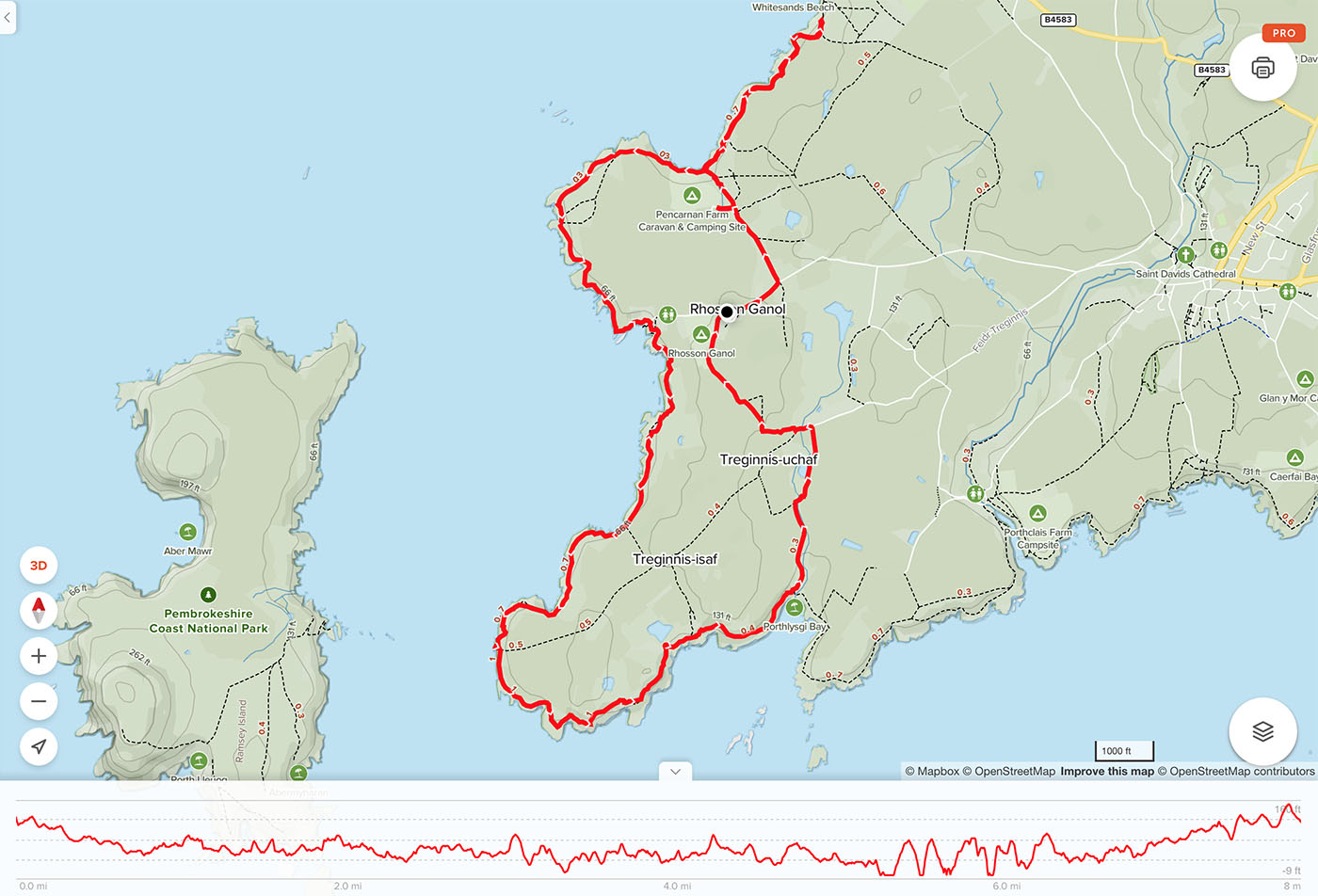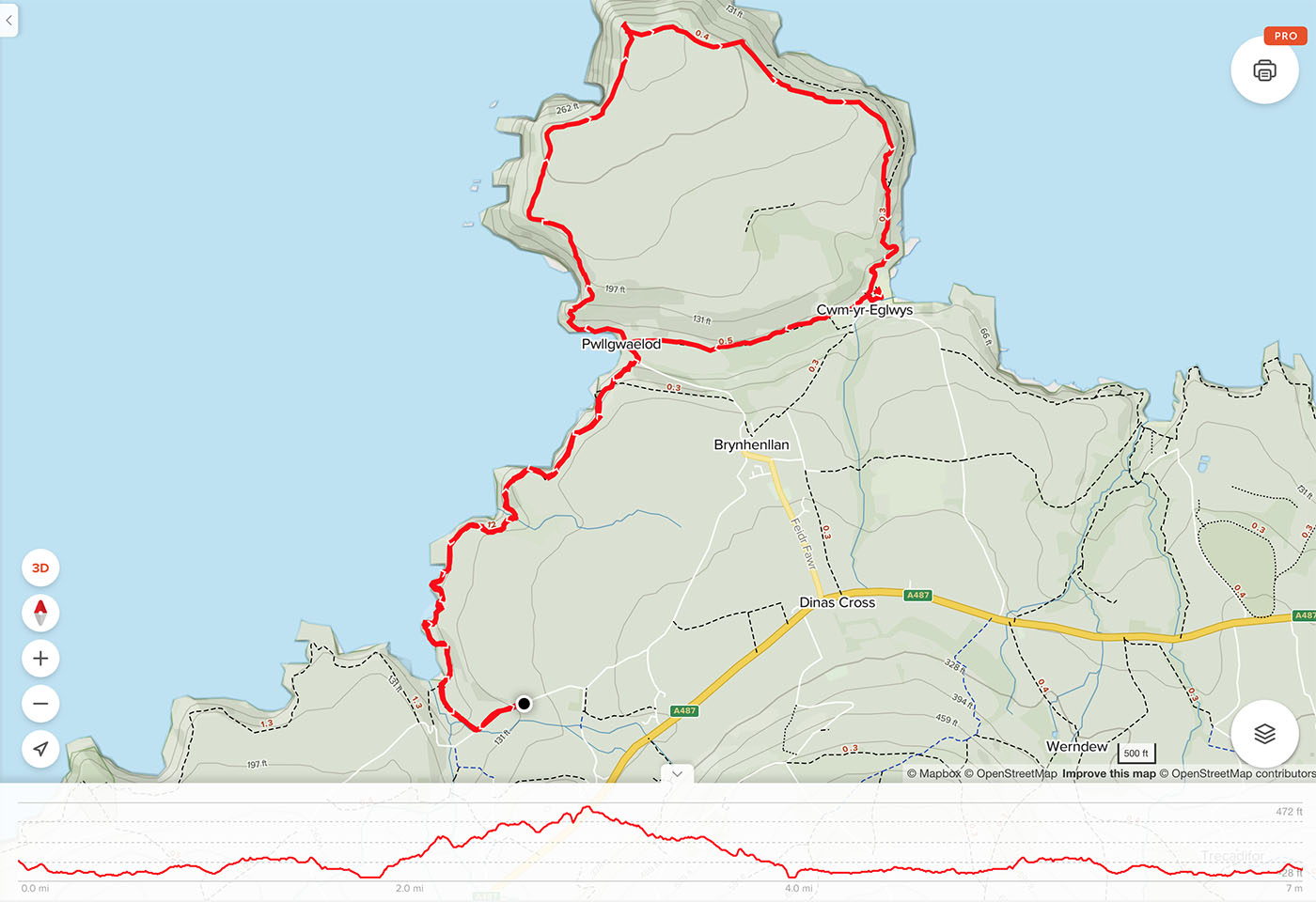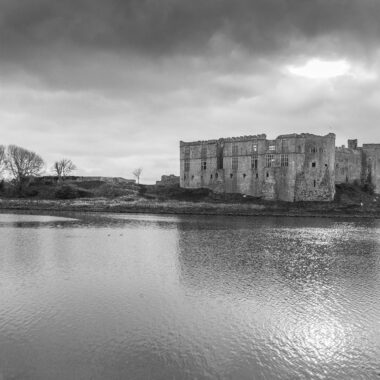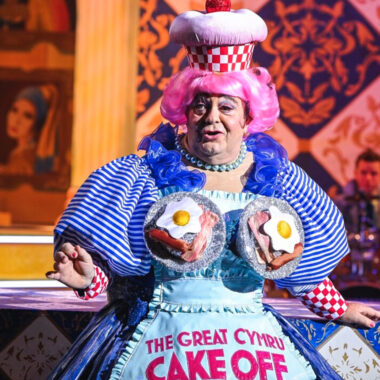It was a bit of a slog from Cornwall in southwestern England around the Bristol Channel and across southern Wales from east to west. The drive had us all longing for the ease and spaciousness of the trains on which we’d traveled around the European continent over the span of more than three months. And of course, the sun gave a rare autumn appearance for the entirety of our drive, making us all wishing we’d spent just one more day in Cornwall to enjoy the rays we’d all been missing! The drive passed reasonably quickly, however, with a marathon through the soundtrack of The Greatest Showman and more than one sing-a-long to Pub Feed.
Get Directions
Our home for our time in Pembrokeshire was in a brilliantly converted old stone barn on a 400+ acre cattle and sheep farm in the sleepy village of Llanychaer. The stone buildings pictured below (our house was the one with the red doors) was the central manor for the Welsh lord who would have inhabited the estate hundreds of years ago. In 1956 the old estate was split up and sold off, bought by the current owner Richard’s great uncle, who was previously a tenant farmer on a portion of the old estate. The farm was unfortunately allowed to deteriorate into a state of disrepair, but Richard and his wife Jo had renovated the bulk of the old buildings and turned the property into a profitable farming enterprise. Richard’s parents also lived on the property, the old man was an absolute hoot with his thick Welsh accent, tottering about the property in his little green Gator, never far from his son’s heels. Richard was an exceedingly welcoming host, always keen to have a chat about the state of the world regardless of how busy he happened to be at the time. Lilia and Max were in heaven with all the space to roam, and were especially enamored with the farm dog, Dotty (she was quite lovable, I will admit, and I’m not a dog person at all [except for when it comes to Nickel Bordessa]). It was an exceptionally comfortable spot to spend a few nights, the wood stove a very nice addition when the northerly winds blew down from the Arctic some evenings.
Nearby Fishguard (population 3400) was the largest town in the immediate area around Llanychaer. There was a regular vehicular ferry leaving from Fishguard for Rosslare in Ireland, and the town also had the claim to fame of being the location of the last invasion of mainland Britain back in 1797. It was a fact that a few tourism operators around town had latched onto, offering tours of locations associated with the battle. The Royal Oak pub – a spot where we enjoyed dinner one night and a weekly folk music performance on another evening – was the site where the French surrendered following their defeat as part of the Battle of Fishguard more than 200 years ago. During our couple of visits to The Royal Oak I’m pretty sure we were about the only guests the bartenders and other patrons didn’t know on a first name basis. But the locals were decidedly welcoming, nonetheless, even clearing a spot for the four of us on folk music night in the aptly named “Locals’ Corner.” The Bridgend Inn – which was on the edge of the farm where we stayed – was also a fun spot to visit after dinner one night, an easy five minute stroll (with flashlights in the pitch black!) down the hill from our abode. As the only patrons that evening, we had a nice chat with the publican by the fire before he closed up for the night, himself a transplant from Yorkshire who’d always wanted to own a pub so decided to buy one in his retirement. We asked him if the Fishguard area typically sees more tourists during the warmer months, to which he responded emphatically in the negative. Such a sleepy yet pleasant part of the world in southwestern Wales: quaint pubs, ancient villages, picturesque coastline and deep green rolling hills covered with sheep and the occasional herd of cattle.
We made a day trip south to Saint Davids Peninsula for a spot of hiking and to visit Saint Davids Cathedral. Similar to the South West Coast Path in Cornwall, the Pembrokeshire coastline is home to the 186 mile/299 kilometer long Coast Path stretching from Saint Dogmaels in the north to Amroth in the south. There were so many walks from which to choose, but the Saint Davids portion was an easy choice given it was a loop encompassing a visit to the cathedral as well as some stunning coastline along the way. Our lunch stop on the eastern side of the channel between the Welsh mainland and Ramsey Island was very picturesque and also a prime location from which to spot dolphins as they frolicked in the raging currents. The cathedral was very impressive, the Romanesque structure’s foundations laid more than 1000 years ago during the reign of King Henry I after Pope Callixtus II granted approval to establish a pilgrimage center in Saint Davids. The four of us enjoyed a stop at Melin Tregwynt on the way home, it was one of the few wool mills still operating in Wales and produced some beautiful woolen goods. Had we the space for them, I think we probably would’ve walked away with a blanket or two (but to be honest, we probably would’ve already had a blanket or two from Portugal if we’d had the space!).
Wales has two official languages: Welsh and English. Every street sign, trail marker and, well, basically any public notification is required to be written in both Welsh and English. The Latin-based languages of continental Europe were relatively easy to understand as we traveled, especially Spanish – given our exposure to Spanish living in California – and Portuguese – Portuguese is quite similar to Spanish. But Welsh… As a Celtic language, the combination of Latin alphabet letters in ways we’d never seen before had us repeatedly twisting our tongues trying to pronounce some of the words we’d see on signs. Only roughly 30% of the Welsh population actually speaks Welsh, and we had trouble finding someone who spoke it fluently (which was somewhat surprising as Max religiously asked every person we met if they spoke Welsh so he could hear it firsthand!). I took a few pics below of some of the signs we came across with their English and Welsh signage. Have fun trying to pronounce the Welsh version!






A little closer to home – Llanychaer was only a few miles from the coast – we explored the Coast Path from the village of Dinas Cross. The trail around the headland of Ynys Dinas crossed more farmland with plenty of sheep for the kids to attempt to befriend along the way. Cwm-yr-Eglwys (try to pronounce that one!) – where we stopped for lunch along the route – looked to be quite the fun spot during the warmer months, with a huge field filled with kayaks and dinghies next to the beach. As it was, we gulped down our sandwiches as quickly as possible so we could escape the frigid northerly wind that kicked up shortly after we stopped for a bite! We stumbled onto a brilliant butcher in Newport just north of Dinas Cross, where we restocked some supplies from the exceptional selection of local meats and seafood: everything from sea bass to cod, rabbit to venison. Max was quite enamored with the pheasants and pig heads hanging by the main window.
We gave our legs a bit of a rest on our last day in Pembrokeshire and adventured down to Carew Castle south of Saint Davids. The castle – where the initial foundations were laid roughly 1000 years ago – was operated by the Pembrokeshire Coast National Park on lease from its owner and came with a very informative self-guided brochure we used to tour the medieval relic. We set a homework assignment for the kids to write about their castle field trip as school for the day (Lilia’s and Max’s are here and here respectively). It was well worth the drive south, really quite an interesting journey through the history of the Pembrokeshire region and the castle itself. We all found ourselves picturing the halls and keeps filled with people hundreds of years ago when the castle was the center of the local economy. The engineering that went into the Tidal Mill – a mill powered by the tidal movements of the Carew River – was very impressive, lots of questions from Max as his cogs turned.
Pembrokeshire was a wonderful stop, it really felt like the end of the earth with its rugged coastline and sleepy villages scattered between the sheep farms and occasional cattle operation. And such lovely people who made us feel so welcome everywhere we visited. Richard and Jo’s farm was the perfect place to unwind during the short daylight hours, I very much enjoyed getting back in the kitchen after being absent for most of our travels across continental Europe (with all the exquisite food on offer across Europe, it was for good reason…).






















































































































Pingback: Conwy Castle 🏰 - Our Walkabout Two
Pingback: Maeshafn and Northern Wales - Our Walkabout Two
Awesome vistas, castles and churches!!!!!!!!! 💖🤗💖 I am so happy for you to see a “bit” of your heritage!
My mum, Poppy, was born in Porthcawl, Wales. So enjoyed all the pictures of Wales.